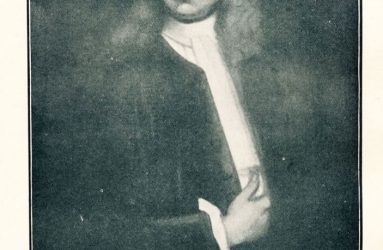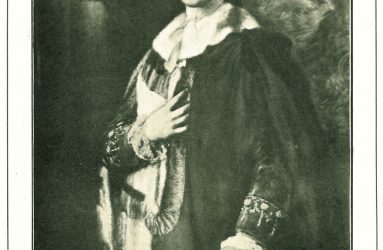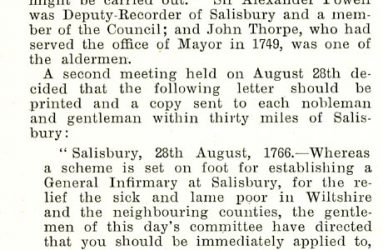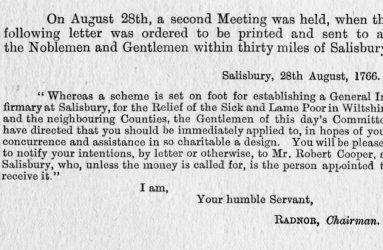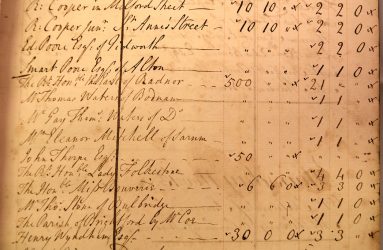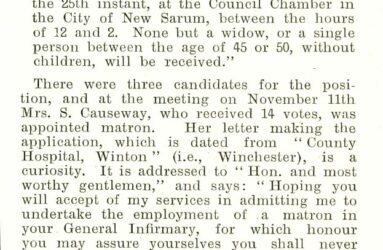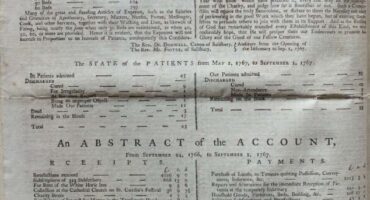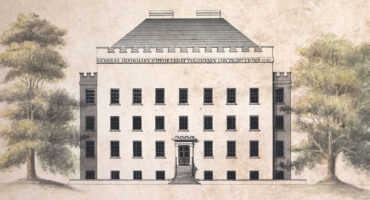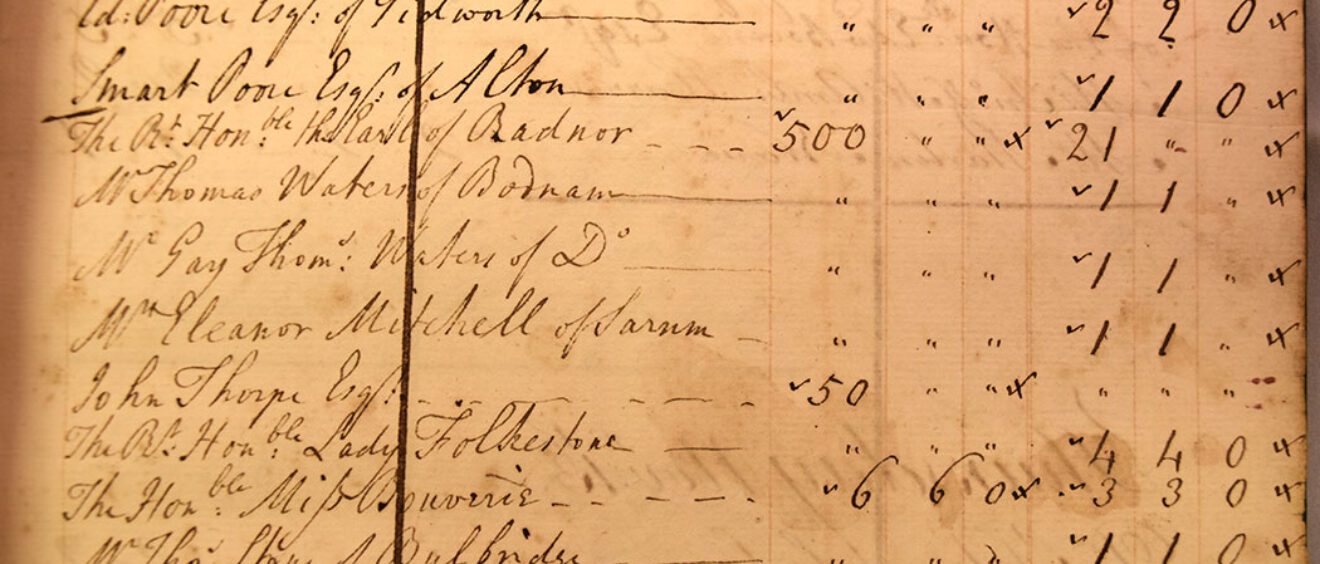
SGI 1767-1870: Introduction
Research by Stuart Wakefield
This study of the Salisbury Infirmary relates to the period from 1765, when the first meeting was held to establish a charity to support a public hospital, until 1870, when the new hospital building was one hundred years old. Primary sources have been key to the research, with the main contributions derived from the Salisbury and Winchester Journal (SWJ) plus the Annual Auditors’ Reports (AR1-3). In addition, a number of contemporary publications have been used to provide secondary sources.
Whilst many facets of medical care improved significantly during the period, several common threads may be noted between hospital care during this period and those of today. These include dealing with an increasing cost-of-living, resisting vaccination, banning smoking, responding to pandemics and overwhelming patient demand. Furthermore, it is considered that those whose advertisements contained outlandish claims for the guaranteed benefits of their medicines have similarities with some of today’s internet influencers.
Inevitably, the primary sources contain variations in spelling and punctuation that are not in common use today, and these have been retained in the quoted text where the original meaning remains clear. All quotations are shown in italics, and lengthy sentences have been retained along with their multiple commas and colons. However, the excessive use of capital letters for emphasis has been reduced. References to the names and years served by Physicians and Surgeon has been taken from the original Infirmary boards that are now mounted in Salisbury District Hospital.
With regards to sterling, 2022 values are shown within square brackets. A number of footnotes indicate the availability of additional detail, and quotation marks surrounding website addresses should be removed if the address is copied. Moreover, accountancy practices evolved during the period, which in some cases has reduced the ability to fully determine costs over the period under study.
1765 SWJ – 4 March; A letter from a well-wisher stated the case for a new hospital in Salisbury. “… this opulent and populous county has for so long been without an hospital … A particular opportunity for beginning a charitable establishment of this sort is now offered by the legacy of the late Lord Feversham, who has bequeathed £500 [£105,543] to the first Infirmary that shall be erected in the County of Wiltshire, within the space of five years after his decease”.
1765 SWJ – 22 July; To encourage action before Lord Feversham’s legacy expired, an extract from his will was published with the comment “… lest for want of attention, his Lordship’s good design be overlooked, and his charitable bequest be lost to the public”.
1766 SWJ – 10 March; The Mayor of Salisbury proposed a meeting for all gentlemen and others, “… who are willing to encourage a public hospital for the county of Wilts, begs the favour of their attendance at the Council House in this city … to consider what is necessary to be done towards carrying this laudable design into execution”. As dictated by the prevailing norms, the invitation would be understood to not include any ladies, irrespective of their social standing.
1766 J8/100/1 In handwritten rough Minutes held at Wiltshire and Chippenham Archives, “Hospital” was crossed out and “Infirmary” written in its place.
1766 SWJ – 2 June; Attention was drawn to key events to coincide with fundraising meetings in an invitation “… the gentlemen and inhabitants of the City and Close of Salisbury, and also of this and the neighbouring Counties, is desired on Monday in the next Assize week, at five of the clock in the afternoon, and again on the second day of the races, at eleven of the clock in the forenoon, at the Vine Inn, in the said City, to consider a scheme for erecting and establishing a General Hospital or Infirmary in or near the said City: At which time a book will be opened for entering Benefactions and Subscriptions: And such Gentlemen as are disposed to encourage this undertaking, and cannot attend in person, are desired to signify their intentions in a letter directed to Mr. Robert Cooper, Linen-Draper, Salisbury”.
The Notice was repeated over the following weeks, and on 14 July, a footnote was added advising that “Upwards of £1,400 [£185,524] are already given or subscribed to this useful undertaking”.
1766 SWJ – 22 September; Extensive support for the proposed Infirmary was reflected in a letter that rejoiced to see that the proposals “… have been so well received … the subscriptions are daily increasing, and will doubtless be very considerable, as this noble design, (which to many will be a Reformatory as well as an Infirmary), is patronised by so many great and good men … but established for the public benefit in a situation where the assistance of Physicians and Surgeons of experience and character is to be obtained …”.
Whilst many word meanings change over time, a hospital may be a building where the sick are diagnosed and treated whereas an infirmary may be a building where the sick or injured are cared for. It is not clear if the Governors intended to make such a difference, as both terms were used in their early announcements. A reformatory focussed upon the spiritual wellbeing of patients.
1766 SWJ – 29 September; Formation of the charity progressed, and it was reported that at a meeting “… of the nobility, gentry, and clergy, at the Council House in Salisbury … it was resolved that a society should be instituted … for the relief of the sick and lame poor, from whatever county recommended. At this meeting, the Earl of Pembroke, was unanimously nominated Visitor, and the Earl of Radnor, President; Messrs. Hoares in Fleet Street, London, were appointed Bankers to the society, and Mr. Robert Cooper, Snr. Of Salisbury, Treasurer. Dr. Hele and Dr. Jacob were at the same time elected Physicians”. A committee likewise was appointed, to purchase ground for building an Infirmary with all possible expedition, and to transact such other business as may be necessary …”.
1766 SWJ – 27 October; Four months after the formation of the charity, a location was advised “… a General Meeting of the Governors of the General Infirmary to be established at Fisherton Anger, near the city of New Sarum, is appointed to be held in the Council Chambers of the said city …”.
1766 Public Infirmary or Hospital, Arguments in Favour: A document was produced to explain why an Infirmary was necessary and to encourage subscriptions by advising that “… it is the only certain way of relieving the poor sick, who are frequently neglected and overlooked in their own homes”.
1766 SWJ – 20 October; At a General Meeting subscriptions were decided. “… it was resolved that as soon as the sum of £600 [£80,456] per annum should be subscribed thereto, the Benefactors and Subscribers should be requested to pay in their respective subscriptions and donations, and whereas … it appears that the Subscriptions amount to the said sum of £600, [£80,456] and upwards; and whereas several houses and land thereunto belonging, proper for the purposes of the said General Infirmary, amounting to £900 [£120,685] and upwards, have been agreed for; It is now resolved, that an advertisement he forthwith published, and this advertisement is published accordingly, earnestly requesting, that : The several Benefactors and Subscribers will be pleased to pay their respective Benefactions and Subscriptions on or before the sixth day of November next …”.
1766 SWJ – 27 October; An advertisement sought for the first Matron at SGI “A Matron – any person, properly recommended may apply … None but a widow, or a single person, between the age of 45 and 55, without children, will be accepted”. Whilst the bar to those with family commitments only applied to those living in the Infirmary, it was also a normal condition applied to those applying for domestic employment.
1766 SWJ – 8 December; Forward planning resulted in a request for building materials. “… a great quantity of bricks will be wanted for building the Salisbury Infirmary, those who are willing to undertake to supply the whole, or any part thereof, are desired to attend the Committee, with their proposals …”.
1766 SWJ – 15 December; A week later, a further request for plans “… all persons willing to engage in building the said Infirmary, that they may bring or send their plans and estimates, sealed up, to the Committee …”.

